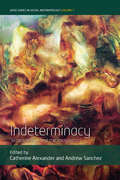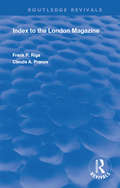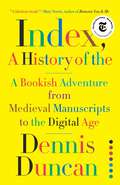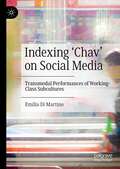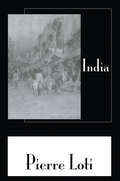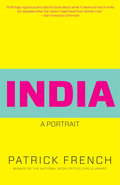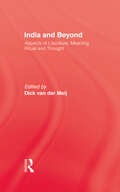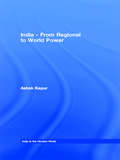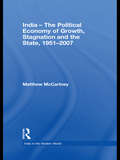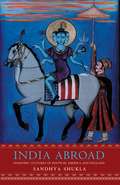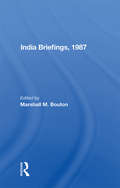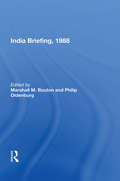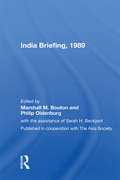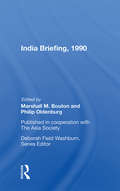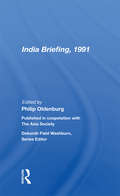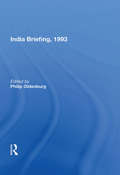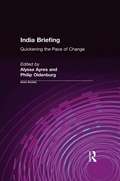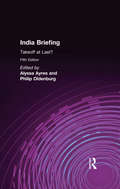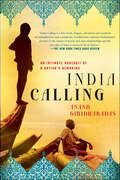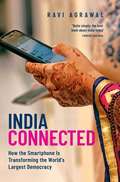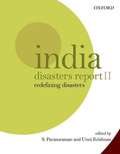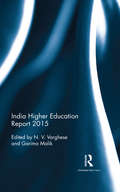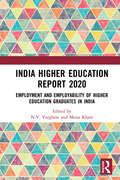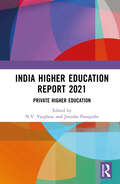- Table View
- List View
Indeterminacy: Waste, Value, and the Imagination (WYSE Series in Social Anthropology #7)
by Catherine Alexander Andrew SanchezWhat happens to people, places and objects that do not fit the ordering regimes and progressive narratives of modernity? Conventional understandings imply that progress leaves such things behind, and excludes them as though they were valueless waste. This volume uses the concept of indeterminacy to explore how conditions of exclusion and abandonment may give rise to new values, as well as to states of despair and alienation. Drawing upon ethnographic research about a wide variety of contexts, the chapters here explore how indeterminacy is created and experienced in relationship to projects of classification and progress.
Index to the London Magazine (Routledge Revivals)
by Frank P. Riga Claude A. PranceThis book was originally published in 1978. The London Magazine is briefly told in the accomplisments and failures of its four editors, and during the fourteen months of his editorship, 1820-21, John Scott succeeded in establishing the London as one of the finest literary periodicals of the nineteenth century. John Taylor, the second editor, maintained the high quality of the magazine by securing many excellent writers. But by the end of 1825, the first year of Henry Southern's editorship, the magazine had lost most of its distinguished writers. When Charles night began editing the London in 1828, its great period was already a memory. This book presents a brief history of the magazine alongside the index.
Index, A History of the: A Bookish Adventure from Medieval Manuscripts to the Digital Age
by Dennis DuncanA New York Times Editors' Choice Book and a New Yorker Best Book of 2022 So Far Named a Most Anticipated Book of 2022 by Literary Hub and Goodreads A playful history of the humble index and its outsized effect on our reading lives. Most of us give little thought to the back of the book—it’s just where you go to look things up. But as Dennis Duncan reveals in this delightful and witty history, hiding in plain sight is an unlikely realm of ambition and obsession, sparring and politicking, pleasure and play. In the pages of the index, we might find Butchers, to be avoided, or Cows that sh-te Fire, or even catch Calvin in his chamber with a Nonne. Here, for the first time, is the secret world of the index: an unsung but extraordinary everyday tool, with an illustrious but little-known past. Charting its curious path from the monasteries and universities of thirteenth-century Europe to Silicon Valley in the twenty-first, Duncan uncovers how it has saved heretics from the stake, kept politicians from high office, and made us all into the readers we are today. We follow it through German print shops and Enlightenment coffee houses, novelists’ living rooms and university laboratories, encountering emperors and popes, philosophers and prime ministers, poets, librarians and—of course—indexers along the way. Revealing its vast role in our evolving literary and intellectual culture, Duncan shows that, for all our anxieties about the Age of Search, we are all index-rakers at heart—and we have been for eight hundred years.
Indexing ‘Chav’ on Social Media: Transmodal Performances of Working-Class Subcultures
by Emilia Di MartinoThe book sets out to examine the concept of 'chav', providing a review of its origins, its characterological figures, the process of enregisterment whereby it has come to be recognized in public discourse, and the traits associated with it in traditional media representations. The author then discusses the 'chav' label in light of recent re-appropriations in social network activity (particularly through the video-sharing app TikTok) and subsequent commentary in the public sphere. She traces the evolution of the term from its use during the first decade of the twenty-first century to make sense of class, status and cultural capital, to its resurgence and the ways in which it is still associated with appearance in gendered and classed ways. She then draws on recent developments in linguistic anthropology and embodied sociocultural linguistics to argue that social media users draw on communicative resources to perform identities that are both situated in specific contexts of discourse and dynamically changing, challenging the idea that geo-sociocultural varieties and mannerisms are the sole way of indexing membership of a community. This volume contends that equating 'chav' with 'underclass' in the most recent uses of the concept on social networks may not be the whole story, and the book will be of interest to sociocultural linguistics and identity researchers, as well as readers in anthropology, sociology, British studies, cultural studies, identity studies, digital humanities, and sociolinguistics.
India
by LotiFirst published in 2002. Routledge is an imprint of Taylor & Francis, an informa company.
India
by Patrick FrenchA monumental biography of the subcontinent from the award-winning author of The World Is What It Is: The Authorized Biography of V. S. Naipaul.Second only to China in the magnitude of its economic miracle and second to none in its potential to shape the new century, India is fast undergoing one of the most momentous transformations the world has ever seen. In this dazzlingly panoramic book, Patrick French chronicles that epic change, telling human stories to explain a larger national narrative.Melding on-the-ground reports with a deep knowledge of history, French exposes the cultural foundations of India's political, economic and social complexities. He reveals how a nation identified with some of the most wretched poverty on earth has simultaneously developed an envied culture of entrepreneurship (here are stories like that of C. K. Ranganathan, who trudged the streets of Cuddalore in the 1980s selling sample packets of shampoo and now employs more than one thousand people). And even more remarkably, French shows how, despite the ancient and persistent traditions of caste, as well as a mind-boggling number of ethnicities and languages, India has nevertheless managed to cohere, evolving into the world's largest democracy, largely fulfilling Jawaharlal Nehru's dream of a secular liberal order.French's inquiry goes to the heart of all the puzzlements that modern India presents: Is this country actually rich or poor? Why has its Muslim population, the second largest on earth, resisted radicalization to such a considerable extent? Why do so many children of Indians who have succeeded in the West want to return "home," despite never having lived in India? Will India become a natural ally of the West, a geostrategic counterweight to the illiberal rising powers China and Russia? To find the answers, French seeks out an astonishing range of characters: from Maoist revolutionaries to Mafia dons, from chained quarry laborers to self-made billionaires. And he delves into the personal lives of the political elite, including the Italian-born Sonia Gandhi, one of the most powerful women in the world.With a familiarity and insight few Westerners could approach, Patrick French provides a vital corrective to the many outdated notions about a uniquely dynamic and consequential nation. His India is a thrilling revelation.From the Hardcover edition.
India & Beyond
by VanFirst published in 1997. Routledge is an imprint of Taylor & Francis, an informa company.
India - From Regional to World Power: From Regional To World Power (India in the Modern World #Vol. 2)
by Ashok KapurThis book provides an in-depth account of India's role in world politics at the beginning of the twenty-first century. The author shows how the approach laid down by Nehru and followed by his successors (an approach that included nuclear self-restraint, the search for friendly relations with Pakistan and China, seeking the high ground in moral and diplomatic spheres, and giving a lead to the non-aligned Third World) has been replaced. The new, more self-confident and assertive approach of this book is based on India's growing economic strength and has a more strategic and pro-Western orientation. Meticulous in approach, this book discusses this change, shows how it has come about, and explores how India's role in world politics might develop going forward. This book will be of interest to students and scholars of South Asian studies, Asian politics, international relations, and security studies.
India - The Political Economy of Growth, Stagnation and the State, 1951-2007 (India in the Modern World)
by Matthew McCartneyUnderstanding the drivers and inhibitors of economic growth is critical for promoting development in less developed countries, including India. This book examines economic growth in India from 1951 to the present, challenging many accepted orthodox views. It argues that growth and stagnation should be considered over the medium term, and that the precise role of the state – in relation to particular historical and political-economic circumstances – is more important than the overall level of state involvement or disengagement. The book uses an empirical approach to contend that the state has an important role in several key areas including: mobilising a surplus; allocating the surplus in an efficient way to productive investment projects; and in building institutions (including political parties) through which conflict can managed between the different losers and rent-seekers affected by economic changes. It shows how, over time and in periods of growth and stagnation, the state in India has acted in key areas, and how the actions of the state has had a profound impact on economic outcomes. Overall, the book makes a major contribution to understanding the economic history of development in India and to understanding the role of the state in economic development more generally.
India Abroad: Diasporic Cultures of Postwar America and England
by Sandhya ShuklaIndia Abroad analyzes the development of Indian diasporas in the United States and England from 1947, the year of Indian independence, to the present. Across different spheres of culture--festivals, entrepreneurial enclaves, fiction, autobiography, newspapers, music, and film--migrants have created India as a way to negotiate life in the multicultural United States and Britain. Sandhya Shukla considers how Indian diaspora has become a contact zone for various formations of identity and discourses of nation. She suggests that carefully reading the production of a diasporic sensibility, one that is not simply an outgrowth of the nation-state, helps us to conceive of multiple imaginaries, of America, England, and India, as articulated to one another. Both the connections and disconnections among peoples who see themselves as in some way Indian are brought into sharp focus by this comparativist approach. This book provides a unique combination of rich ethnographic work and textual readings to illuminate the theoretical concerns central to the growing fields of diaspora studies and transnational cultural studies. Shukla argues that the multi-sitedness of diaspora compels a rethinking of time and space in anthropology, as well as in other disciplines. Necessarily, the standpoint of global belonging and citizenship makes the boundaries of the "America" in American studies a good deal more porous. And in dialogue with South Asian studies and Asian American studies, this book situates postcolonial Indian subjectivity within migrants' transnational recastings of the meanings of race and ethnicity. Interweaving conceptual and material understandings of diaspora, India Abroad finds that in constructed Indias, we can see the contradictions of identity and nation that are central to the globalized condition in which all peoples, displaced and otherwise, live.
India Briefing, 1987
by Marshall M. BoutonThis annual review of major events, issues, and trends in Indian affairs presents an authoritative and insightful assessment of India in 1986. Interpretive essays illuminate the causes and consequences of a tumultuous year, as leading specialists discuss Indian politics, economy, society, culture, and foreign relations. The contributors examine such important developments as the breakdown of the Punjab accord, the resurgence of militant communalism, Prime Minister Rajiv Gandhi's faltering leadership, the dramatic heightening of Indo-Pakistan tensions, the growing resistance to economic reforms, and the impact of the video revolution on Indian culture. Filling an important gap in the literature on contemporary Indian affairs, this book will be invaluable for students and scholars of South Asia as well as for journalists, policymakers, businesspeople, and serious travelers who wish to understand current and future developments in India.
India Briefing, 1988
by Marshall M. Bouton Philip OldenburgThis second volume in the series of annual assessments of key events and trends in Indian affairs offers an overview of Indian politics, economy, and foreign relations in 1987. It thoroughly examines important topics in Indian life, national security, science and technology, and education.
India Briefing, 1989
by Marshall M. BoutonIndia Briefing, 1989 is the third in a series of annual assessments of key events and issues in Indian affairs prepared by the Contemporary Affairs Department of The Asia Society. It covers the year's developments in Indian politics, foreign policy, and the economy.
India Briefing, 1990
by Marshall M. Bouton Philip OldenburgThis book aims to bring to readers an understanding of important developments in Indian affairs in 1990. It analyzes the role of resurgent Hinduism in India's political and social order and looks at the economy, foreign relations, law and poverty.
India Briefing, 1991
by Philip OldenburgThis book examines India's perception of its international role in relation to post-Cold War global realignment, describes social and literary movements among India's "Untouchables," and reviews the ongoing struggle over Kashmir. It presents comprehensive analyses of politics and the economy.
India Briefing, 1993
by Philip OldenburgA common theme in the India Briefing series has been India's resilience in the face of turmoil and tragedy. This year's volume demonstrates that India is under greater stress than ever before. In the country's severest test, India's secular foundations were shaken by the storming and destruction of the Barbi mosque in Ayodhya. This act of violence
India Briefing: 2001 (Asia Society Country Briefing Ser.)
by Philip Oldenburg Alyssa AyresIn the time between 1998 and the publication of this text, India held two national elections and began the second phase of economic reforms. This work examines these political, economic, social and cultural developments in India from 1998 to the end of 2000.
India Briefing: Takeoff at Last? (Asia Society Country Briefing Ser.)
by Philip Oldenburg Alyssa AyresSince 2001, India has gained new attention as an emerging world power with a rapidly growing economy, a world-class science and technology sector, and a huge English-speaking labor pool. After a period of escalating tension with neighbor Pakistan, wide-ranging peace talks are underway. Within India, there is an unprecedented mood of optimism about the future. At the same time, the nation wrestles with difficult questions about the place of secularism in society, the role it sees for itself globally and within Asia, and the reality that millions of Indians still live at the subsistence level. This volume of India Briefing examines India's changing fortunes through chapters that cover the economy; the twists and turns of domestic politics; labor in the large informal sector; the cultural roots of Hindu nationalism; the foreign relations rollercoaster; the business of Bollywood; and a special chapter on the range of new resources about India available on the web.
India Calling: An Intimate Portrait Of A Nation's Remaking
by Anand GiridharadasAnand Giridharadas sensed something was afoot as his plane from America prepared to land in Bombay. An elderly passenger looked at him and said, "We're all trying to go that way," pointing to the rear. "You, you're going this way?"Giridharadas was returning to the land of his ancestors, amid an unlikely economic boom. But he was more interested in its cultural upheaval, as a new generation has sought to reconcile old traditions and customs with new ambitions and dreams. In India Calling, he brings to life the people and the dilemmas of India today, through the prism of his émigré family history and his childhood memories of India. He introduces us to entrepreneurs, radicals, industrialists, and religious seekers, but, most of all, to Indian families. Through their stories, and his own, he paints an intimate portrait of a country becoming modern while striving to remain itself.
India Calling: An Intimate Portrait of a Nation's Remaking
by Anand GiridharadasReversing his parents’ immigrant path, a young American-born writer returns to India and discovers an old country making itself new.Anand Giridharadas sensed something was afoot as his plane from America prepared to land in Bombay. An elderly passenger looked at him and said, “We’re all trying to go that way,” pointing to the rear. “You, you’re going this way?” Giridharadas was returning to the land of his ancestors, amid an unlikely economic boom. But he was more interested in India’s cultural upheaval, as a new generation has sought to reconcile old traditions and customs with new ambitions and dreams.In India Calling, Giridharadas brings to life the people and the dilemmas of India today, through the prism of his émigré family history, introducing us to entrepreneurs, radicals, industrialists, and religious seekers, and, most of all, to Indian families. Through their stories, and his own, he paints an intimate portrait of a country becoming modern while striving to remain itself.Praise for India Calling“A fine book, elegant, self-aware and unafraid of contradictions and complexity. Giridharadas captures fundamental changes in the nature of family and class relationships and the very idea of what it means to be an Indian.” —The New York Times Book Review“[A] smart, evocative and sharply observed memoir . . . Giridharadas’s narrative gusto makes the familiar fresh.” —The Wall Street Journal“[A] readable, intriguing book . . . [Giridharadas is] a marvelous journalist—intrepid, easy to like, curious . . . India Calling connects us to a new India, and an engaging new voice.” —The Plain Dealer (Cleveland)
India Connected: How the Smartphone is Transforming the World's Largest Democracy
by Ravi AgrawalIndia is connecting at a dizzying pace. In 2000, roughly 20 million Indians had access to the internet. In 2017, 465 million were online, with three new people logging on for the first time every second. By 2020, the country's online community is projected to exceed 700 million; more than a billion Indians are expected to be online by 2025. While users in Western countries progressed steadily over the years from dial-up connections on PCs, to broadband access, wireless, and now 4G data on phones, in India most have leapfrogged straight into the digital world with smartphones and affordable data plans. What effect is all this having on the ancient and traditionally rural culture dominated by family and local customs? Ravi Agrawal's book explores that very question, seeking out the nexuses of change and those swept up in them. Smartphones now influence arranged marriages, create an extension of one's social identity that moves beyond caste, bring within reach educational opportunities undreamed of a generation ago, bridge linguistic gaps, provide outlets and opportunities for start-ups, and are helping to move the entire Indian economy from cash- to credit-based. The effects are everywhere, and they are transformative. While they offer immediate access to so much for so many, smartphones are creating no Utopia in a culture still struggling with poverty, illiteracy, corruption, gender inequality, and income disparity. Internet access has provided greater opportunities to women and altered how India's outcasts interact with the world; it has also made pornography readily available and provided an echo chamber for rumor and prejudice. Under a government determined to control content, it has created tensions. And in a climate of hypernationalism, it has fomented violence and even terrorism. The influence of smartphones on the world's largest democracy is pervasive and irreversible, disruptive and creative, unsettling and compelling. Agrawal's fascinating book gives us the people and places reflecting what the internet hath wrought. India Connected reveals both its staggering dimensions and implications, illuminating how it is affecting the progress of progress itself.
India Disasters Report II: Redefining Disasters
by S. Parasuraman Unni KrishnanIndia Disasters Report II highlights the reality of disaster vulnerability in India due to natural causes and developmental interventions. It emphasizes the need to look at disasters as an outcome of processes rather than stand-alone events. Adopting a multidisciplinary approach, this Report emphasizes the importance of understanding the causes, effects, and complex dynamics of disasters. It asserts the need to link natural systems, social systems, and technological limitations to devise policies and action plans for disaster prevention, relief operations, and environmentally-inclusive development. With climate change becoming a global concern, India now has laws and policies, national, state, and district level administrative set-ups, and humanitarian initiatives in place for disaster preparedness and response measures. Exploring diverse issues such as vulnerability, development, environment, gender, health, and information, communication, and technology, in disasters, this Report discusses recent disasters in India and how new thinking affects policy initiatives and actual practice in disaster management.
India Higher Education Report 2015
by N. V. Varghese Garima MalikThe unprecedented expansion of higher education in India and the proliferation of providers in turn have posed enormous challenges to equity, quality and financing of the sector. The India Higher Education Report 2015 traces the evolution of higher education and discusses the key role of committees and commissions whose reports and recommendations form the backdrop of contemporary developments. Authoritative and comprehensive, the volume examines a range of themes including equity, financing, employment, quality, and governance. It also engages with new and recent data as well as current issues and debates. The volume will be an important resource for academics, policy makers, civil society organisations, media and those concerned with higher education. It will also be useful to scholars and researchers of public policy, sociology and economics.
India Higher Education Report 2020: Employment and Employability of Higher Education Graduates in India
by N. V. Varghese Mona KhareIndia Higher Education Report 2020 critically analyzes the role played by the state, industries, and higher education institutions in the employment and employability of educated youth in India. The book discusses a wide range of topics such as employability skill gaps of higher education graduates; curriculum and skills training systems; formal and informal modes of skill formation; crisis of jobless growth in India; migration, education and employment; dimensions of gender, caste and education; general, technical and professional education; vocationalization; qualifications framework and skills certifications; curriculum and pedagogy in higher education for skill development; industry–academia linkages; entrepreneurship education and executive education; and sustainable employment. The book focuses on theoretical insights, empirical evidences and recent data on key issues and challenges of higher education graduate employment in a knowledge economy driven by the unprecedented expansion of higher education and increasing digitization. It offers successful cases of institutional responses, examples of policy and practices as also perspectives of different stakeholders such as employers, employees, teachers and students to present trends in the changing landscape of higher education and future demands of the job market for the youth workforce across sectors, subject disciplines and gender. This volume will be an important resource for scholars, teachers and researchers of higher education, public policy, political economy, political science, labour studies, economics, education, sociology in general as well as for policymakers, professional organizations and associations, civil society organizations, and government bodies.
India Higher Education Report 2021: Private Higher Education
by N. V. Varghese Jinusha PanigrahiThis volume provides an in-depth analysis of the critical dimensions of higher education in India. It focuses on the growth and expansion of private higher education and public policy. The volume discusses issues related to the growth of for-profit and not-for-profit private higher education institutions and their implications at the policy level. It outlines the role of such institutions towards the internationalization and global ranking of the Indian higher education system. The book discusses the trends in internationalisation adopted by private higher education institutions and explains the resulting impact on aspects such as the diversity of programs, skill formation, employability, pedagogic practices, standards, curriculum development, and research and development, as well as the wider externalities in terms of promoting India’s soft power and international relations with other countries. While outlining the challenges of Open Distance Learning (ODL) and online education in India, the book also discusses the use of ICT, OER, and MOOCS among others to address the challenges of the ODL system. This volume will be of interest to teachers, students, and researchers of education, public policy, political science, international relations, law, sociology, economics, and political economy. It will also be useful for academicians, policymakers, and anyone interested in the internationalization of Indian Higher Education.
